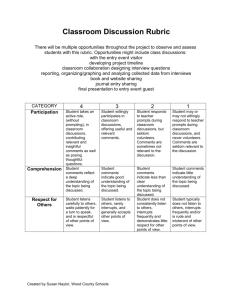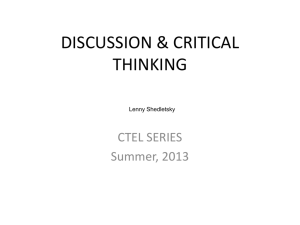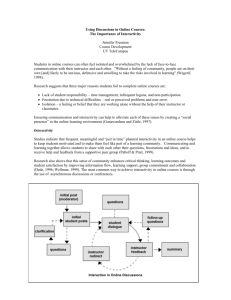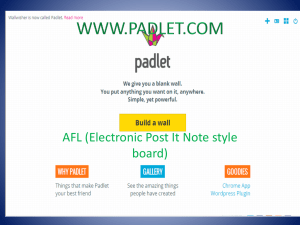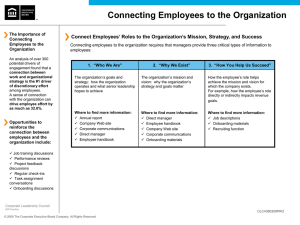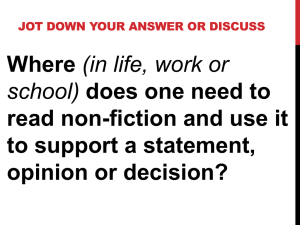Hdfs 447
advertisement
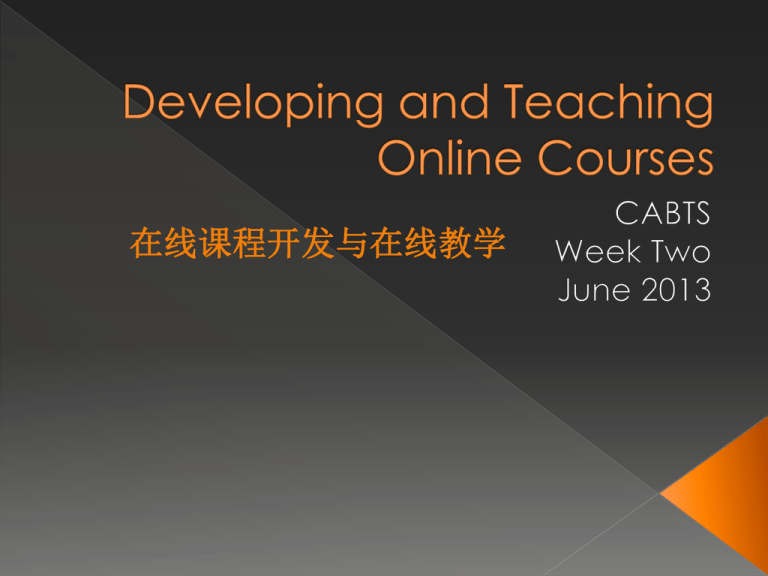
在线课程开发与在线教学 学习成果 Reminding students of the learning goals (outcomes) at key intervals helps students to identify their progress and to understand why they are performing certain learning activities. Let’s review our outcomes. Rate 1-5 if you believe we have addressed the outcome already. 每隔一段时间提醒学生 学习目标(成果)有助 于他们确定其进度,理 解为什么他们要进行特 定的学习活动。 让我们回顾一下学习成 果。如果你确信我们已 经搞明白学习成果了, 请举手。 学习成果 1. 2. Compare and contrast the demands of preparing a course for on-campus delivery vs. for online delivery Explain and apply the concept of alignment as it pertains to outcomes, assessments, assignments, learning activities and course materials 1. 对筹划一门线下课程 和筹划一门在线课程 的要求进行比较。 2. 解释并运用一致性 的概念,因为它涉及 结果、评价、作业、 学习活动和课程材料。 学习成果 3. 4. Explain the concept of active learning and its significance in online education Apply active learning strategies in the design of online course materials 3. 解释在线教育中主动 学习的概念及其意义。 4. 设计在线课程材料时, 应用主动学习的策略。 学习成果 5. 6. Draft effective online discussion questions, policies, and facilitation strategies to encourage a culture of robust discussion and participation. Identify and apply strategies and tools to engage online learners 5. 列出有效的在线讨论问 题、策略及便利化政策, 以鼓励踊跃讨论和参与 的氛围。 6. 确定并应用吸引在线学 习者的策略和手段。 学习成果 7. 8. Explore options for providing feedback on student work Identify strategies for facilitating online courses to meet the communication needs of online students 7. 探讨就学生作业进行 反馈的选项。 8. 确定有助于在线课程 的策略,以满足在线 学生的需求。 作业概要 Discuss the online discussion › How would you describe the discussion, compared to a face-to-face discussion? 讨论“在线讨论” > 与面对面讨论比较, 你会如何描述在线 讨论。 面对面讨论与在线讨论 How are they alike? How are they different? 它们有何相似之处 它们有何不同之处 面对面讨论 Immediate, synchronous Nonverbal communication Usually not graded “Temporary” in Nature 直接、同步 非文字交流 通常不评分 具有“临时”特性 在线讨论 Asynchronous Mostly written communication Usually graded Permanent written record of what was said 非同步 大多数情况下通过文字 交流 通常会被评分 所交流的内容以文字记 录永久保留 影响 Discussions are important in both learning environments However, we must change the way we structure and facilitate discussions online to achieve the same quality, to achieve the same outcomes. 两种学习环境下的讨 论都是重要的。 但是,为达到和面对 面讨论同样的质量和 效果,我们必须改变 组织和促进在线讨论 的方式。 设计欠佳的在线讨论 Shallow Narrow Awkward Can feel like “busy work” (meaningless) Can emphasize speaking (writing) over listening (reading) 深度不够 面窄 令人尴尬 感觉像“忙碌的工作” (无意义) 强调说(写)重于听 (读) What are some qualities that lead to poorly designed online discussions? 什么特性导致在线讨论设计欠佳 非强制的讨论 Online students don’t often opt for optional learning activities 在线学生不常选择非强 制的学习活动 教师缺席 Instructors making the online discussion forum for students only 教师只为学生组织在线 讨论论坛。 宽松的参与策略 Not explaining when, how, and where to interact leaves students wondering … and not participating 没有说明何时、如何、 在哪互动,使得学生感 到困惑且不参与。 封闭式问题 Asking students close-ended questions with definite, concrete answers leaves them with not much to say 询问学生有明确、具体 答案的封闭式问题,使 得学生没有太多可说。 排队模式及回答模式 Answer One Question and Reply to Two Peers 回答一个问题,回复给 两个同行(同学) 排队模式存在的问题 Leads to repetitive answers Latecomers have nothing to contribute Invites plagiarism Limits the scope of the discussion Has a purpose of assessment instead of discussion 不断重复答案 迟到的人失去回答的机 会 导致剽窃 限制讨论范围 意在评估而非讨论 替代:发起讨论 Instead of posting a question that all students must answer, post a discussion starter Then, add follow-up questions 用发起讨论的帖子替代 所有学生必须回答一个 问题的帖子 然后,添加问题 独立思考—结对讨论—交流分享 What was the most interesting thing you learned from the readings this weekend? 你从本周末的阅读材料 中学到的最有趣的事情 是什么? 教师在推动在线讨论方面的作用 Cheer students on; let them know when they are right Highlight important points Question students; ask them to clarify and expand Correct misunderstandings Provide direct instruction 使学生振作起来,在他们 正确的时候要让他们知道 突出重点 向学生提问,要求他们澄 清并扩充回答 对误解进行修正 提供直接的指导 通过在线讨论教会学生批判性思考 Critical thinking is “the intellectually disciplined process of actively and skillfully conceptualizing, applying, analyzing, synthesizing, and/or evaluating information gathered from, or generated by, observation, experience, reflection, reasoning, or communication, as a guide to belief and action.” ~Michael Scriven and Richard Paul 批判性思考是“积极地 、熟练地解析、应用、 分析、综合、评价所获 得的信息,这些信息来 自于观察、实验、思考 、推理和交流,并用其 指导信念和行动。” 通过在线讨论教会学生批判性思考 Online discussions (when designed and facilitated well) often evoke more critical thinking than inperson discussions Let’s practice evoking critical thinking with each other using Socratic Questioning Prompts 在线讨论比面对面讨论 更能带动批判性思考 (特别是在设计和推动 工作做得好的时候)。 让我们运用苏格拉底式 提问带动批判性思考。 苏格拉底式提问 Small groups, choose a speaker Speaker, tell the group about a hobby you enjoy Listeners, use the Socratic Questioning Prompts to get your speaker to encourage the speaker to think more critically about his or her hobby 分成小组,选出一名发 言人。 发言人,告诉所在小组 你的一个爱好。 听众,运用苏格拉底式 提问鼓励发言人对他或 她的爱好进行批判性思 考。 思考 Listeners: How did the Socratic questions affect what the speaker shared? What more did you learn as a result? Speakers: How did these prompting questions affect your thought process? 听众:苏格拉底式提问 如何影响发言人所分享 的内容?你从中更多的 学到了什么? 发言人:这些提问如何 影响你的思维过程? 对在线讨论评分 我们如何对讨论进行评分? Frequency of participation Quantity (number of posts, or number of words per post) Correctness of expression Quality 参与的频率 数量(帖子数量、帖子 的字数) 表达的正确性 质量 参与频率 — 独立思考,结对讨论,交流分享 Which do you suppose is more important? 你认为哪一个更重要? A. 帖子的总数量 B. 学生参与的总天数 为什么? A. The total number of posts B. The total number of days on which students participate Why? Two speakers, one counter For 5 minutes, speakers engage in conversation about your hometowns Counters, tally the number of times the speaker changes from one to the other In 5 minutes, how many back-and-forth exchanges were there? 2个发言人,1个计数人 5分钟,发言人进行有 关家乡的谈话 计数人,计算发言人交 替发言的次数 5分钟内来回替换多少 次? 讨论帖质量评价:活动 In small groups, discuss what a high, medium, and low quality discussion post look like. Together: Brainstorm what “quality” looks like. 分组讨论高、中、低质 量的讨论帖子是什么样 的。 集体讨论:头脑风暴, “质量” 指的是什么。 一般情况下,讨论帖子的“质量”是什么意思? Posts move the conversation forward Students demonstrate their growing understanding of course concepts Students demonstrate that they are completing and understanding the course readings 帖子促进交谈。 学生展示他们对课程 概念理解的程度。 学生展示他们对课程 阅读材料完成和理解 的情况。 质量指标 Students show that they are reading and considering other posts, not just writing Students use examples, offer explanations, and pose thoughtprovoking questions Students demonstrate critical thinking 学生表现出他们不 只是写贴,也在阅 读或思考其他人的 帖子。 学生运用实例,进 行解释,提出值得 深思的问题。 学生展示其批判性 思考。 质量指标 Demonstration of doing course readings Quotations plus analysis Critiques Length of contribution Not repeating what others have already said; listening Questioning Applying course material to real life 展示课程学习的阅读材料 引用并分析 评论 帖子的长度 不重复别人所说过的;倾 听 提问 在实际中运用课程材料 构建一个强大在线讨论文化 Train students to participate in discussions Grade frequently Use a rubric for grading Give specific feedback Be interested and engaged Call students out by name Ask follow up questions Reward with praise 培训学生参与讨论 经常评分 运用规则进行评分 给予详细的反馈 感兴趣且积极参与 叫出学生的名字 追问问题 夸奖学生 活动 Working in small groups, create a POORLY designed discussion question for an online class Present your question, and explain why it is poorly designed Revise your question to make it better 按小组活动,为在 线课堂创建一个设 计欠佳的讨论问题。 提出你的问题,并 解释为何这个设计 较差。 修改问题使其变得 更好。 回顾:在线讨论小窍门 Participation requirements Facilitation Grading Open-ended questions Consciously challenge critical thinking skills Remember that discussions are conversations, not quizzes 参与要求 推动 评分 开放式问题 有意识挑战批判性思 考能力 切记讨论是对话而不 是问答比赛 高级的在线讨论: 让我们变得更有创意 讨论的各种变化 Debates/Role Playing Peer Review Think-Pair-Share (Group Tool) Jigsaw Padlet 辩论/角色扮演 学生间互相评议 独立思考—结对沟通— 分享交流(小组工具) 拼图游戏 Padlet(一种网页故事 墙写作工具) 讨论的各种变化 Webquests (Research & Report Back) Presentations with Q&A Surveys 网络专题调查(研究及 报告反馈) 演讲展示+问答 调研 使枯燥的讨论问题更加吸引人 Small groups, take a plain discussion question and make it more engaging Use the ideas on the next slide, or come up with something new 分成小组,把一个平 淡的讨论问题变得更 加吸引人。 运用下一张幻灯片上 的建议,或提出新的 建议。 建议 Debates/Role Playing Peer Review Think-Pair-Share (Group Tool) Jigsaw Padlet Webquests (Research & Report Back) Presentations with Q&A Surveys 辩论/角色扮演 学生间互相评议 独立思考—结对讨论—分 享交流(小组工具) 拼图游戏 Padlet 网络专题调查(研究及报 告反馈) 演讲展示+问答 调查 在线讨论工具 Combining discussion boards with other tools adds even more variety! › Word Clouds › Images › Photo share › Voice recording › Video recording 将讨论板与其他工具结 合起来,甚至增加更多 种类的工具 > 文字云(制作标签) > 图像 > 图片共享 > 录音 > 录像 • • • Synthesize readings Prioritize or rank items in terms of relative importance Reflect on major topics and course outcomes 综合阅读资料 对相对重要的内容排出 优先顺序或分级 思考主要议题和课程成 果 在线图片管理及分享/网络相册 Enter a few vocabulary words up to a paragraph of text The FlickrPoet search engine finds related photos from Flickr based on tags, titles, and descriptions Works with any website that offers a group of images to choose from 输入几个词或一段文字。 FlickrPoet搜索引擎可以 通过基于Flickr的标签、 标题和说明查找到相关的 照片。 任何网站都可提供一组图 片以供选择。 简单讨论 What is photosynthesis? “How green plants use sunlight to change carbon dioxide and water into carbohydrates and oxygen.” I agree! Well said! 什么是光合作用? “绿色植物利用太阳光 将二氧化碳和水转化成 碳水化合物和氧气。” Me, too. 我同意 说得好 我也同意 通过FlickrPoet或其它图片网站进行讨论 光合作用 阳光 氧气 原创讨论帖——受到图片的启发 Photosynthesis, in this picture, is a magical, complex process that happens everywhere, all around us. You put in sunlight and water, and then stand back like this guy in the picture, and you get carbohydrates and oxygen. It’s kind of amazing, but in this picture, it’s in the middle of an ordinary field, showing that it’s extraordinary and ordinary all at the same time. 在这张图片中,光合 作用是一种神奇的、 复杂的过程,这个过 程在我们周围的每一 个地方都在发生。只 要你提供了阳光和水, 然后像图中的那个人 一样,站在一旁,你 就会得到碳水化合物 和氧气,这很不可思 议。图片中的普通田 野上,显示出其平凡 和普通。 The second picture shows a musical instrument. The instrument itself doesn’t make the music – you need someone to actually play it. You need that energy. And you take that person’s movements and combine it with the instrument, and out comes music. Likewise, photosynthesis takes sunlight and water and changes it into carbohydrates and oxygen. 这张图向我们展示了一个 乐器。这个乐器自己并不 能发出音乐——需要有人 去演奏。你需要能量。那 么,你得让这个人拿着乐 器动起来,音乐便一泻而 出。同样,光合作用就是 把阳光和水转化成了碳水 化合物和氧气。 The third picture shows the valve on an oxygen tank. To me, this shows that we can bottle up what photosynthesis produces and use it. This process is valuable, very valuable, to human beings. 第三张图片是氧气罐的阀 门,对我来说,它表现的 是我们能够将光合作用的 产物装入罐中。这个过程 对于人类来说非常非常有 价值。 学生创作的图片 Document field trips and labs Share hand-created drawings, sketches Take a picture in the field and pose a question to the instructor or class 记录实地考察和实验 分享手绘的素描、速写 现场拍摄照片,向老师 提出一个问题 Jing 视频截屏 Free tool Create & annotate screenshots Create screencast video recordings you narrate Upload to screencast.com and share with a URL 免费工具 创建和注解截图 对创建的截屏视频录像 进行旁白 上传到 screencast.com,用 一个网址(URL)来共 享 Jing, on your computer Screencast.com account, online Jing的用途 Mini-lectures, showing images, PPT slides, or whatever you can show on screen Web-tours Software demos Announcements Discussion of complex assignments 小型讲座, 展示图片、 PPT 幻灯片, 或者你想展示的任 何东西 Web-tours(网上订票系 统) 软件演示 公告 复杂作业的讨论 Jing的更多用途 Feedback on student work Discussion posts – bring your voice to the conversation Student use for presentations and discussions 对学生作业进行反馈 讨论帖——用音频对话 学生用以演讲和讨论 音频工具 Audioboo.fm Chirbit.com 视频工具 Voicethread Video sharing sites Mindmeister.com 绘图工具 一种数码绘图板 回顾活动:就在线讨论建立联系 Share one tip you learned about designing, facilitating, or grading online discussions Training facilitators, help make connections between related ideas using string 分享你在学习在线 讨论设计、推动和 评分后的一个心得。 培训协调员,利用 字符串把相关想法 联系起来。 除了讨论:其它交流需求 除了讨论:其他交流需求 Technology issues and questions › For you and for tech support Schedule/Turnaround Times for Responding Grade early/Grade often Announcements Email Getting Started Email 技术问题和疑问 > 教学支持 回答的时间表/周期 及早评分/经常评分 公告 电子邮件 用电子邮件告知学生如 何入门 用电子邮件告诉学生如何入门 Imagine you are a first-time online student. What do you need to know to get started? In small groups, create a list 想象一下你是第一次做 在线学生,如果要开始 你需要知道些什么? 分小组活动,列出清单 所有这些交流需要花很多时间! 跟上交流的需求 Question and Answer Forum Direct traffic where you want it to go Rubrics Voice Recordings Shortkeys Demo 问答论坛 指挥交通,让学生去往 你预设的地方 说明 录音 快捷键演示 制定沟通计划 Communication Needs: Getting Started Making Progress Wrapping Up Clarifying Concepts Responding to Student Work Responding to Student Questions State Turnaround Times 交流需要: 开始 不断推进 总结 对概念进行澄清 对学生的作业要有反馈 对学生的问题要有反馈 说明时间周期 交互学习的模块 One way to replicate face to face teaching is to create interactive learning modules that provide feedback to students as they work through the module 复制面授的一个方法是 创建交互学习模块,当 学生通过模块学习时, 为学生提供反馈。 玩游戏 Practice games are good, low-stakes methods of helping students study 玩游戏是帮助学生学 习的好方式,风险低。 把你所知道的课堂学习方法应用于在线学习, 进行调整使之更吸引人 使面授的经验适于在线教育 Survival Activity for the Face to Face Professional Science Masters class Instructor thought of recording the oncampus version and showing online students the video 理工科硕士班专业课程, 课堂上的生存挑战活动 教师把课堂授课的录像 在线展示给学生 生存挑战活动 生存挑战活动 家庭作业 Adapt an oncampus activity for presentation online Share it with our group tomorrow 把一个适于校园的活动 放在网上 明天与你的小组成员分 享 复习 Share your activity Describe the oncampus activity Describe or show the online activity 分享活动 描述校园活动 描述或展示在线活动 便利性 Technical accessibility 技术上的便利 > 学生是否有软件并能上网? 是否拥有必要的工具? 对于残障学生的便利 > 残障学生能够参加学习吗? › Do students have software and Internet connectivity? Do they have tools they need? Accessibility for students with disabilities › Can disabled students participate? 残障学生 May use screen readers May have limited mobility May be color-blind Design for these students from the start 可能使用屏幕阅读器 可能移动受限 可能是色盲 从一开始设计就要考虑 这类学生 实验室 Online labs are possible! › Labs using household equipment › Field labs (observe/experimen t report, analyze) › Occupational safety & ergonomics labs 在线实验室是可能的 > 使用家庭设施进行 实验 > 田间实验室(观察 /实验报告、分析) > 职业安全及人体工 程学实验室 在线实验室的优点和缺点 Difficult to control materials and methods More time to complete each lab More one-on-one feedback More participation from individual students Opportunity to focus locally 难以控制材料和方法 完成每个实验需要更多 时间 更多的一对一反馈 单个学生参与的更多 有机会更多关注本地情 况 实验室的考虑 May require multimedia development, lab kits, household equipment › Lake Stratification (FW 456/556) May require student use of multimedia 可能需要多媒体制作、 试剂盒、家庭设备 > 湖水分层 (FW 456/556) 可能要求学生运用多媒 体 对初始者的建议 Start simply Develop the course fully in advance Be comfortable with the technology Plan to interact with students Be positive in communications Have backup plans 从简单开始 提前开发课程 用技术实现最理想的 效果 与学生互动的计划 积极交流 有备用计划 综合与总结 You’ve heard a lot of ideas … What excites you the most? What will your online class definitely include? 你学到了很多理念 你最激动的是什么? 你的在线课程包括些什 么? 幻灯片展示 结业典礼
